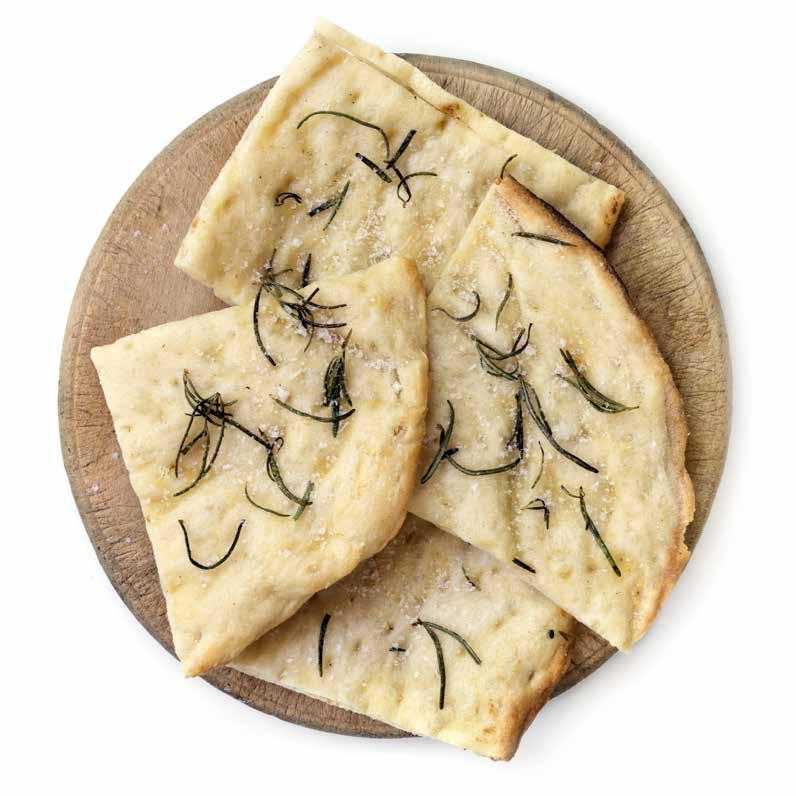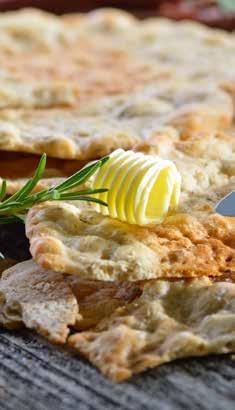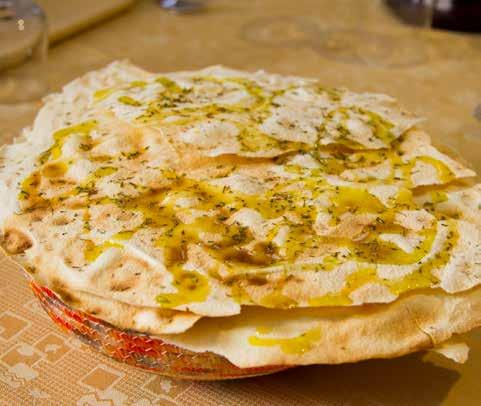
3 minute read
Country Flatbread
Country Flatbread the versatile cracker:
dip it... dunk it... snack it!
Advertisement
BY MORRIS LEMIRE
What is a flatbread?
There is no clear consensus. Some of them are not all that flat.
Nearly every culture in every corner of the world, from Mezo-America to
Malaysia, had an unleavened bread that was relatively flat. That universality alone accounts for their many varieties.
You can well imagine that the kinds of food they ate them with often determined how the bread was used, as a dish or a spoon, reminding us that flatbreads are hand-held.
Traditionally, flatbreads didn’t use wild local yeast as a rising agent. When people travelled in caravans, or watched over herds of cattle and sheep, they cooked over an open fire, on a stone or cast-iron pan. Waiting for dough to rise was a non-starter. Preparing flatbread was fast, convenient, requiring few ingredients, while offering culinary flexibility. Leftovers were easy to pack-up and kept well without spoiling. Nomadic or sedentary, flatbread making was and still is a daily task in many parts of the world.
Today the majority of flatbreads still don’t use yeast, although many do. Of course there are other rising agents, some of them hard to avoid, like air for example. Baking powder and baking soda cause bread to rise, as does egg white,
fermentation and steam. In Alberta we usually add about 1 tsp of baking soda to our breakfast pancakes (yup! they’re a flatbread), which makes them just a little softer and fluffier.
Wikipedia lists 146 kinds of flat bread, which can be grouped into about 30 categories. In our case, and only for comparison, two types are considered, flexible and crispy. If the bread is to be used as a wrap, e.g. a tortilla, or as a scoop like naan, then flex works best. In our recipe what you are after is the exact opposite, a dry, crisp cracker that breaks with a snap.
This dry cracker type has several advantages; it keeps well, travels well, and it makes a great lunchbox snack. You can dip it into salsa, break it into soup, or use it as a party snack on its own. If your social gatherings are like mine, friends follow their nose straight into the kitchen. As these aromatic beauties come out of the oven, let your guests brush on their own olive oil and salt and like the bread itself, you’ll be golden.
Crisp Flatbreads
Makes about 18
3 cups (750 g) semolina flour: coarse-grained. Semolina is durum wheat 3 cups (570 g) white flour, unbleached (Note the lighter weight) 2 tsp salt, plus extra for sprinkling on the cooked bread 3 Tbs fresh rosemary, chopped fine ½ cup (125 mL) extra virgin olive oil, plus extra to brush on the warm bread 1⅔ cups (400 mL) water
Note: Recipe can be halved
1. In a large bowl, combine the two flours, salt and rosemary. 2. Make a well in the center and pour the oil and water into the well; gently mix. 3. Knead the dough right in the bowl until smooth, about 3 minutes. Avoid over handling the dough, or you’ll make it tough. 4. Carefully form a ball, then cover with plastic wrap, (don’t let the dough dry-out) and put in the fridge for an hour or two. This prevents fermentation or rising, and gives the gluten a chance to relax. 5. Five minutes before taking the dough out of the fridge, put a baking stone or tray into the oven, and only then heat the oven to 450° F. 6. From the ball, pull off a piece of dough about the size of a large egg, about 120 g. Keep the remaining dough covered. 7. Using your hand, flatten the working piece of dough on a lightly floured surface. 8. Working from the middle, use a rolling pin to roll the dough as thin as possible, 1 mm to about 22 cm diameter. 9. Using a wide flipper, carefully place the flattened disk onto the stone/tray. 10. Bake for 8 minutes until the bread is crisp and golden brown. Remove from oven onto a cooling rack, let cool for a minute or so and then brush with olive oil and sprinkle with salt.
Note: If this is your first-time making flatbread on-the-go, pay close attention to organizing your workspace. You could make some ahead of time and warm them up.

Morris Lemire lives in Edmonton where he spends the summer gardening and winter skiing. He likes winter, in part, because citrus is plentiful. He uses citrus in everything from marmalade to preserved lemons, cocktails to meringues.











